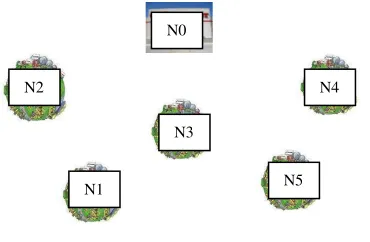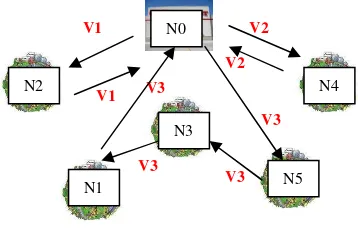SOLVING CAPACITATED VEHICLE ROUTING
PROBLEMS WITH TIME WINDOWS BY
GOAL PROGRAMMING APPROACH
ATMINI
DHORURI
1,
EMINUGROHO
RATNA
SARI
2,
AND
DWI
LESTARI
31Department of Mathematics, Yogyakarta State University, atmini_uny@yahoo.co.id
2Department of Mathematics, Yogyakarta State University, eminugrohosari@gmail.com
3Department of Mathematics, Yogyakarta State University, dwilestari@uny.ac.id
Abstract. This paper presents how to build multiobjective linear programming model as solution of Capacitated Vehicle Routing Problem with Time Windows (CVRPTW). We use a goal programming approach to solve the model. We have discussed an objective function for two main goals: the first is to minimize the total number of vehicles and the second is to minimize the travelling time of the used vehicles. The proposed model is applied to a problem distribution of Liquefied Petroleum Gas (LPG). Computational results of the proposed model are discussed.
Key words and Phrases: CVRPTW, goal programming, objective function.
1. Introduction
ATMINI D., EMINUGROHO R.S, AND DWI L.
Vehicle Routing Problem (VRP) is a class of problem in which a set of routes for a fleet of delivery vehicles based at one or several depots must be determined for a number of customers. Main objective of VRP for serving known customer demands by a minimum-cost vehicle routing starting and ending at a depot. Vehicle Routing Problem (VRP) which reducing the cost while delivering on time, namely VRP Time Windows (VRPTW), has become popular issue in optimization research. On the other hand, if the distribution depends on the capacity of vehicle, it is called Capacitated VRP (CVRP) [7]. In this paper, we discuss the CVRP with time windows (CVRPTW). It means that the vehicles must arrive to the customer in a restricted time interval which is given. It can be stated as follows: find a feasible solution of the vehicles, so that to minimize both, the number of vehicles used and the total travel time. To solve the problem, we develop a goal programming model which has more than one goal in the objective function, even its goal contradict each other.
A goal programming approach is an important technique for modelling and helping decision-makers to solve multi objective problems in finding a set of feasible solutions. The purpose of goal programming is to minimize the deviations between the achievement of goals and their aspiration levels [8]. Based on Azi et.al [1], Jolai and Aghdaghi [4], if VRP has a time constrains on the periods of the day in which each customer must be visited, it is called Vehicle Routing Problem with Time Window (VRPTW). Belfiore, et.al [2], Calvete, et.al [3] and Hashimoto, et al [5] have developed VRP with time windows. Ombuki, et.al [6] have applied a multi objective genetics algorithm to solve VRPTW. Sousa,et al [7] have used a multi objective approach to solve a goods distribution by The Just in Time Delivery S.A, a distribution company using Mixed Integer Linear Programming.
In this paper, we present a goal programming model as solution of Capacitated Vehicle Routing Problem with Time Windows (CVRPTW). The objective function are two main goals: the first is to minimize the total number of vehicles and the second is to minimize the travelling time of the used vehicles. Computational results of the proposed model will be discussed. The paper is organized as follows, in Section 2: the mathematical models of Capacitated Vehicle Routing Problem with Time Windows (CVRPTW). In Section 3, Computational results of the proposed model using a set of data obtained. Finally in Section 4, we describe conclusions.
2. Mathematical Models
We formulate CVRPTW model with 5 nodes (customers location) and reasoning as follow:
We assume that the average velocity of vehicle is constant.
Let
V
=
{
1, 2,...,
v
}
represents the fleet of vehicles,N
=
{
0,1, 2,...,
n
+
1
}
meaning the set of all nodes including depot, each node representing a customer location. Every vehicle must depart from depot and terminate at node n+1. We formulate the problem as a graph G N A( , ) where A is the set of directed arc (the network connections between the customer and the depot) [7]. Each connection is assosiated with a travel time
time
ij,
∀ ∈
i j
,
N i
,
≠
j
. Time window for customer i,. It means the vehicle must arrive between that interval time.
The following of mathematical symbols and decision variables used in this paper:
- C : the set of n customers.
- The connection between node i to j using vehicle k.
1
, active
,
,
,
,
,
1,
0.
0
, not
ijk
x
∀ ∈ ∀ ∈
i j
N
k
V
i
≠
j i
≠ +
n
j
≠
-
t
ik: time when vehicle k come on node i, ,∀ ∈i N,∀ ∈k V. - : time window for customer i
-
D
i : demand or quantity of goods for customer i- : vehicle capacity
- T : constant parameter to consider in the time window
constraint ∞.
- : negative deviational variable of first goal
- : positive deviational variable of second goal
Goal Programming Model
To generate a goal programming model for the problem, we set the following goals:
Goal 1 : minimize the total number of vehicles/ avoid underutilization of vehicle capacity
Goal 2 : minimize the travelling time of the used vehicles.
ATMINI D., EMINUGROHO R.S, AND DWI L.
1 1 2 2
Min
V k k
Z
=
ω
∑
d
−+
ω
d
+ (1)subject to
2
time
0
V N N
ijk ij k i j
x
−
d
+=
∑∑∑
. (2)1 ,
V N ijk k j
x
=
∀ ∈
i
C
∑∑
(3)0
1 ,
N jk j
x
=
∀ ∈
k
V
∑
(4)0 ,
,
N N
iak ajk
i j
x
−
x
=
∀ ∈ ∀ ∈
i
C
k
V
∑
∑
(5), 1,
1 ,
N i n k i
x
+=
∀ ∈
k
V
∑
(6)1
,
C N
i ijk k k i j
D
x
+
d
−=
Q
∀ ∈
k
V
∑ ∑
(7)(
)
time 1 , , , ,
ik ij ijk jk
t + −T −x ≤t ∀i j∈N ∀ ∈k V T → +∞ (8)
,
,
ai ik bi
t
≤ ≤
t
t
∀ ∈ ∀ ∈
i
N
k V
(9){ }
0,1
,
,
,
ijk
x
∈
∀ ∈ ∀ ∈
i j
N
k
V
(10)0 ,
,
ik
t
≥
∀ ∈ ∀ ∈
i
C
k V
(11)Based on the model, Eq.(3) is a constraint to ensure that one vehicle visits each customer only. Constrains in Eq.(4), Eq.(5), and Eq(6) to guarantee that each vehicle depart from depot, a vehicle unload the goods after comes to a customer and then go to the next customer . Eq.(7) shows the vehicles only maximum loaded in its capacity. The constraint in Eq.(8) guarantee feasibility of the time schedule of a service time. Eq.(9) is a constraint that represent the time windows for every customer. Decision variables are represented by Eq.(10) and Eq.(11).
3. Computational Results
Time
units Depot A B C D E
Depot 0 7 8 10 3 8
A 5 0 5 6 6 7
B 7 3 0 5 6 8
C 6 2 3 0 7 6
D 4 5 5 7 0 8
E 7 8 8 6 9 0
Table 2. Demand and time windows for each customer
Customer A B C D E
Demand (units) 90 200 100 125 100
ta (time units) 7 8 10 3 8
tb (time units) 37 75 43 45 41
[image:5.612.127.488.145.267.2]The customers can be described like shown as follows:
Figure 1. Depot and Customers
A computational process is done using LINGO. The following result obtained routes as Fig. 2.
N2
N1
N0
N3
N4
[image:5.612.228.413.431.552.2]ATMINI D., EMINUGROHO R.S, AND DWI L.
V1
V1
V2 V2
V3
V3 V3
V3
V1
V1 V2
V2 V2
[image:6.612.226.405.123.238.2]V2
[image:6.612.217.396.305.408.2]Figure 2. Depot and Customers Route Using Vehicle’s Capacity 300 units
Figure 3. Depot and Customers Route Using Vehicle’s Capacity 560 units
Figure 2 Shows that we need three vehicles to satisfy the customer’s demand. If we increase the capacity of the vehicles to 560 units, the result can be showed in Fig,3 above. It means, only needs two vehicles to distribute the demands.
4. Conclusion
In this paper we proposed a multi objective linear programming approach to solve a Capacitated Vehicle Routing Problem with Time Windows (CVRPTW). Two goals are to minimize both, the number of vehicles used and the total travel time. The model is applied in the distribution of LPG with five customers. Time windows are very important to be considered. So the travel time can be minimized. As future development we suggest to improve the method to solve CVRPTW.
N2
N1
N0
N3
N4
N5
N1
N2
N0
N3
N4
[1] Azi N., Gendreau M., Potvin J. 2007. An exact algorithm for a single-vehicle routing problem with time windows and multiple routes; European Journal of
Operational Research. 178 pp 755-766.
[2] Belfiore, P., Hugo Tsugunobu, Yoshida Yoshizaki. 2008. Scatter Search for Vehicle Routing Problem with Time Windows and Split Deliveries. Journal
Compilation. I-Tech Education and Publishing KG, Vienna, Austria.
[3] Calvete H.I., Gale C., Oliveros M.J. 2007. Valverde B.S., A goal programming approach to vehicle routing problems with soft time windows; European Journal
of Operational Research 177; 1720-1733
[4] Jolai, F. and Aghdaghi, M. 2008. A Goal Programming Model for Single Vehicle Routing Problem with Multiple Routes . Journal of Industrial and Systems
Engineering Vol. 2, No. 2, pp 154-163, Summer 2008.
[5] Hashimoto H., Ibaraki T., Imahori S., Yagiura M. 2006. The vehicle routing problem with flexible time windows and traveling times; Discrete Applied
Mathematics 154; 1364-1383
[6] Ombuki B., Ross B.J., Hanshar F. 2006. Multi-Objective Genetic Algorithms for Vehicle Routing Problem with Time Windows; Applied Intelligence 24; 17–30
[7] Sousa, J.C., Biswas, H.A., Brito, R., and Silveria, A., A Multi Objective Approach to Solve Capacitated Vehicle Routing Problems with Time Windows
Using Mixed Integer Linear Programming. International Journal of Advanced
Science and Technology, Vol. 28, March, 2011.

